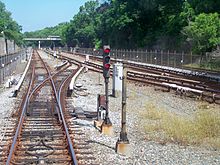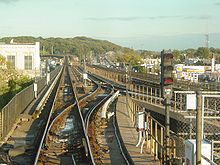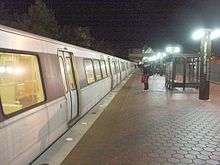- Washington Metro signaling and operation
-
Signaling and operation on the Washington Metro system involves train control, station identification, train signaling, signage, and train length. As with any working railroad, communication between train operators, dispatchers, station personnel and passengers is critical. Failures will result in delays, accidents, and even fatalities. It is therefore important that a comprehensive signal system operated by a central authority be in place. This gives individual train and station operators the information they need to safely and efficiently perform their tasks.
Contents
Train control
Metro uses an automatic train control (ATC) system, which comprises three sub-systems. Automatic Train Protection protects trains; it is designed to separate them so that collisions will not occur. Automatic train supervision routes trains and assists in maintaining adherence to schedule.[1] Together, these two sub-systems provide input to the train's cab signals[2] and to a third sub-system, Automatic Train Operation, which can control the trains directly. Because of a 2009 collision caused by an automatic train control malfunction, Metro no longer uses the Automatic Train Operation sub-system.
The Automatic Train Protection system uses coded track circuit technology originally supplied by Rochester-based General Railway Signal when the line was constructed in the 1970s. This system is vital (safety critical), and provides a continuous stream of information to the train regarding the maximum safe speed via the running rails. Speed commands are designed to ensure trains maintain a safe stopping distance from any obstruction and do not exceed the speed limit for any segment of track. The system stops trains in advance of any other train traffic, and before Stop signals at interlockings. The cab signal system relies on lineside equipment to detect track occupancy and send the appropriate speed code.[1][2] Although the automatic train protection system was designed to be fail-safe, the track circuit control equipment on which it relies has been prone to parasitic oscillations which can cause the system intermittently to fail to detect the presence of a train.[1] This resulted in a collision in 2009,[1] after which Metro began to operate all trains manually.[3]
The Automatic Train Supervision sub-system provides for headway management and proper interleaving of trains at junctions by speeding up or slowing down trains.[1] The system works via a series of track mounted balises,[citation needed] which function as information beacons transmitting a speed code to the train as it passes overhead. Its designers intended its function to be non-vital, and for this reason its design is not fail-safe.[2] At no point can the ATC system override the maximum speed limit enforced by the cab signal system.
All trains are manned with train operators who work the doors, make station announcements, and supervise their train. The train operator also controls whether the train operates in automatic mode or manual mode. From November 17, 1995 until January 6, 1996, Metro management required its employees to use the automatic mode at all times. Automatic Train Operation controls trains so that, between stations, they will move at the speed specified by the automatic train protection and automatic train supervision sub-systems. During the Blizzard of 1996, however, there was a collision on January 6 that occurred when the automatic train supervision system failed to pick up proper instructions from the wayside communication system during a snowstorm, and defaulted to the highest speed.[2] This speed would have been safe during dry weather, but because of ice or snow, trains required additional stopping distance, which was not provided for by the automatic train control system. On June 22, 2009, parasitic oscillations in a track circuit module that is part of the automatic train protection system caused a train that was in automatic mode to collide with a stopped train;[1] since then, Metrorail operators have been operating the trains exclusively in manual mode. The automatic train protection system still limits the maximum speed of every train that is in revenue (passenger-carrying) service.
An automated announcement system will be equipped on the 7000 series rolling stock.
Non-revenue tracks (storage tracks, tail tracks, yard tracks) are not equipped with ATC. Green signs with letters reading “START ATC” and “END ATC” mark the beginning and ending respectively of ATC territory.
Station identification
The system’s rail lines run on ten lettered routes. Within these routes, each station is also identified by a letter and number system based on the route letter and the station number in ascending order from the system’s geographic center. This is known as the Remote Terminal Unit (RTU) number. The RTU number identifies the station and nearby track controlled by the station’s wayside control room to Metro’s Central Control. Metro Center, Gallery Place, L'Enfant Plaza, and Fort Totten have two RTU numbers - one for each level.
Metro’s lettered routes are as follows:[4]
- A Route: Metro Center to Shady Grove
- B Route: Metro Center to Glenmont
- C Route: Metro Center to Huntington via Arlington Cemetery
- D Route: Metro Center to New Carrollton
- E Route: Gallery Place to Greenbelt
- F Route: Gallery Place to Branch Avenue
- G Route: D&G Junction east of Stadium-Armory to Largo Town Center
- J Route: C&J Junction south of King Street – Old Town to Franconia-Springfield
- K Route: C&K Junction south of Rosslyn to Vienna
- L Route: F&L Junction south of L'Enfant Plaza to C&L Junction north of Pentagon via Fenwick Bridge
- N Route (planned): K&N Junction east of West Falls Church to Route 772
There are no H, I, or M Routes. The originally-intended H Route ultimately became the present J Route, and "I" was never used as a route letter. The M Route would likely be assigned to a future route to Lincolnia, branching off from the C Route south of Pentagon station.
Signaling
Fixed signals are only present at interlockings. They show a red over red aspect for “stop and stay,” a lunar (white) aspect for “proceed,” and a flashing lunar aspect for “proceed on diverging route” (only present on newer interlockings; older interlockings are being updated with signals that show this aspect). Tracks are divided into block sections, which can only be occupied by one train at a time, a method to protect against collisions used by most railway systems worldwide, but there are generally no fixed signals to protect block sections (signals tend to be only at beginning/end of route and just before track switches). Virtual signal aspects are transmitted to the train by a cab signaling system and displayed to the operator in the cab, as well as transmitted to the ATC system. Entry into an occupied block is prevented by an automatic train protection system (ATP), which supervises both manual and ATC operation and stops the train well before it would enter an occupied block.
At switches entering into pocket tracks in a direction reverse to the normal operating direction, there is a “P Signal”. The P Signal is a single lunar signal that displays the letter “P” and is found at the entrance to some but not all pocket tracks and other selected main line interlockings in the reverse direction of the normal flow of traffic. Below the P signal on the same post is a punch box to allow the train operator to manually set the switch to the diverting direction (reverse) when the P Signal is lit. The P signal is only lit when a train occupies the two track circuit approaching the P Signal and all possible routes into the interlocking are not occupied.
Signage
Two trackside signs exist: The “S”-Sign is posted at revenue tracks and indicates to the operator that a station is ahead. It is located at a distance no greater than 1200 feet (365.75 m) before a station platform. The “TB”-Sign is posted to indicate to the operator that an eight-car train (the longest used in the system) is clear of an interlocking (“turnback”) when the train front is flush with the sign, and that the train can turn back in the direction from which it came on the opposite track.
Train length
The most common train length is six cars, with a maximum length of eight cars possible. Usually six or eight cars are used during rush hour and four or six cars during weekends and late evenings. Metro has now begun their phased introduction of eight car trains on the Red, Orange, and Green lines during morning rush hour.[5] By the end of this implementation, Metro hopes to end usage of four car trains from the system on weekdays, except at night.[6] During the several days prior, Metro also tested eight car trains on Yellow and Blue lines in preparation for increased service the day of the inauguration.[7][8]
References
- ^ a b c d e f Railroad Accident Report: Collision of Two Washington Metropolitan Area Transit Authority Metrorail Trains Near Fort Totten Station, Washington, D.C., June 22, 2009, National Transportation Safety Board, 10/27/2010, http://www.ntsb.gov/doclib/reports/2010/RAR1002.pdf, retrieved 03/04/2011.
- ^ a b c d Railroad Accident Report: Collision Of Washington Metropolitan Area Transit Authority Train T-111 With Standing Train At Shady Grove Passenger Station, Gaithersburg, Maryland, January 6, 1996, National Transportation Safety Board, 10/29/1996, http://www.ntsb.gov/doclib/reports/1996/RAR9604.pdf, retrieved 03/04/2011.
- ^ John Catoe. "Working to Make Metro Safer". The Washington Post. http://www.washingtonpost.com/wp-dyn/content/article/2009/07/03/AR2009070301776_pf.html.
- ^ "John R. Cambron's WMATA Track Schematics". Mysite.verizon.net. http://mysite.verizon.net/cambronj/. Retrieved 2009-07-16.
- ^ Metro Unveils New 6000 Series Train On Green Line
- ^ Washington Metropolitan Area Transit Authority Approved Fiscal 2010 Annual Budget, page 91.
- ^ "Metro - About Metro - News - Metro tests additional eight-car trains on the Blue, Orange and Red lines next week" (Press release). Wmata.com. 2009-01-02. http://www.wmata.com/about_metro/news/PressReleaseDetail.cfm?ReleaseID=2397. Retrieved 2009-07-16.
- ^ "Metro - About Metro - News - Half of all Metrorail trains will be eight cars next week" (Press release). Wmata.com. 2009-01-09. http://www.wmata.com/about_metro/news/PressReleaseDetail.cfm?ReleaseID=2407. Retrieved 2009-07-16.
Washington Metropolitan Area Transit Authority Services 
Metrorail lines Future projects General managers Jackson Graham • Warren D. Quenstedt • Theodore C. Lutz • Richard S. Page • Carmen E. Turner • William A. Boleyn • David L. Gunn • Lawrence G. Reuter • Robert Polk • Richard A. White • Dan Tangherlini • John B. Catoe Jr. • Richard SarlesRelated articles List of Metro stations • Metro Access • Metro Transit Police Department • Major incidents • Metro rolling stock • Metro signaling and operation • SmarTripCategories:
Wikimedia Foundation. 2010.




